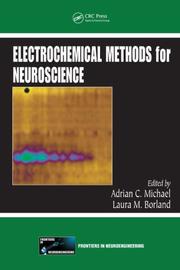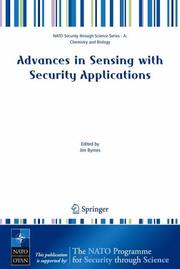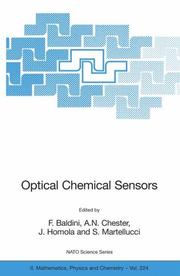| Listing 1 - 3 of 3 |
Sort by
|

ISBN: 0849340756 9786610733101 1280733101 1420005863 0429127170 Year: 2006 Publisher: Boca Raton, Fla. : London : CRC ; Taylor & Francis [distributor],
Abstract | Keywords | Export | Availability | Bookmark
 Loading...
Loading...Choose an application
- Reference Manager
- EndNote
- RefWorks (Direct export to RefWorks)
Since the first implant of a carbon microelectrode in a rat 35 years ago, there have been substantial advances in the sensitivity, selectivity and temporal resolution of electrochemical techniques. Today, these methods provide neurochemical information that is not accessible by other means. The growing recognition of the versatility of electrochemical techniques indicates a need for a greater understanding of the scientific foundation and use of these powerful tools.Electrochemical Methods for Neuroscience provides an updated summary of the current, albeit evolving, state of the art an
Electrochemical sensors. --- Neurophysiologic monitoring --- Intraoperative neurophysiologic monitoring --- Monitoring, Intraoperative neurophysiologic --- Monitoring, Neurophysiologic --- Monitoring, Neurophysiologic intraoperative --- Neurophysiologic intraoperative monitoring --- Electrochemical detectors --- Methodology. --- Intraoperative monitoring --- Chemical detectors

ISBN: 9781402042843 1402042841 9786610427130 1280427132 1402042957 Year: 2006 Publisher: Dordrecht, Netherlands ; London, England : Springer,
Abstract | Keywords | Export | Availability | Bookmark
 Loading...
Loading...Choose an application
- Reference Manager
- EndNote
- RefWorks (Direct export to RefWorks)
The chapters in this volume were presented at the July 2005NATO Advanced Study Institute on Advances in Sensing with Security Applications. The conference was held at the beautiful Il Ciocco resort near Lucca, in the glorious Tuscany region of northern Italy. Once again we gathered at this idyllic spot to explore and extend the reciprocity between mathematics and engineering. The dynamic interaction - tween world-renowned scientists from the usually disparate communities of pure mathematicians and applied scientists which occurred at our six previous ASI’s continued at this meeting. The fusion of basic ideas in mathematics, biology, and chemistry with ongoing improvements in hardware and computation offers the promise of much more sophisticated and accurate sensing capabilities than currently exist. Coupled with the dramatic rise in the need for surveillance in innumerable aspects of our daily lives, brought about by hostile acts deemed unimaginable only a few short years ago, the time was right for scientists in the diverse areas of sensing and security to join together in a concerted effort to combat the new brands of terrorism. This ASI was one important initial step. To encompass the diverse nature of the subject and the varied backgrounds of the anticipated participants, the ASI was divided into three broadly defined but interrelated areas: the - creasing need for fast and accurate sensing, the scientific underpinnings of the ongoing revolution in sensing, and specific sensing algorithms and techniques. The ASI brought together world leaders from academia, government, and industry, with extensive multidisciplinary backgrounds evidenced by their research and participation in numerous workshops and conferences.
Detectors --- Remote sensing --- Chemical detectors --- Radar --- Terrorism --- Détecteurs --- Télédétection --- Détecteurs de produits chimiques --- Terrorisme --- Prevention --- Prévention --- Chemical detectors -- Congresses. --- Detectors -- Congresses. --- Remote sensing -- Congresses. --- Subjects Radar -- Congresses. --- Terrorism -- Prevention -- Congresses. --- Geography --- Electrical & Computer Engineering --- Engineering & Applied Sciences --- Earth & Environmental Sciences --- Electrical Engineering --- Geography-General --- Engineering. --- Analytical chemistry. --- Pattern recognition. --- Remote sensing. --- Applied mathematics. --- Engineering mathematics. --- Computer mathematics. --- Industrial engineering. --- Production engineering. --- Industrial and Production Engineering. --- Pattern Recognition. --- Remote Sensing/Photogrammetry. --- Applications of Mathematics. --- Computational Science and Engineering. --- Analytical Chemistry. --- Optical pattern recognition. --- Mathematics. --- Computer science. --- Analytical biochemistry. --- Math --- Science --- Optical data processing --- Pattern perception --- Perceptrons --- Visual discrimination --- Management engineering --- Simplification in industry --- Engineering --- Value analysis (Cost control) --- Analytic biochemistry --- Biochemistry --- Chemistry, Analytic --- Informatics --- Bioanalytic chemistry --- Bioanalytical chemistry --- Analytical chemistry --- Analysis, Chemical --- Analytic chemistry --- Chemical analysis --- Chemistry --- Computer mathematics --- Electronic data processing --- Mathematics --- Engineering analysis --- Mathematical analysis --- Remote-sensing imagery --- Remote sensing systems --- Remote terrain sensing --- Sensing, Remote --- Terrain sensing, Remote --- Aerial photogrammetry --- Aerospace telemetry --- Space optics --- Design perception --- Pattern recognition --- Form perception --- Perception --- Figure-ground perception --- Manufacturing engineering --- Process engineering --- Industrial engineering --- Mechanical engineering --- Sensing --- Security applications

ISBN: 9781402046117 140204609X 9781402046094 1402046103 9786611107543 1281107549 1402046111 Year: 2006 Volume: vol. 224 Publisher: Dordrecht Springer
Abstract | Keywords | Export | Availability | Bookmark
 Loading...
Loading...Choose an application
- Reference Manager
- EndNote
- RefWorks (Direct export to RefWorks)
Chemical sensing using optics is under extensive research all over the world and many optical chemical sensors are finding increasing application in industry, environmental monitoring, medicine, biomedicine and chemical analysis. This is evidenced by an annual growth in the number of international scientific conferences in which advances in the field of optical chemical sensors are reported. These conferences, are, however, focused on disseminating the latest scientific results rather than providing in-depth education in the field of optical chemical sensors. In addition, the topic of optical chemical sensors is only just beginning to find its way into the curricula of universities and colleges in Europe and in the US. Due to the prominence that optical sensors are assuming, it has become more and more important to establish a framework for discussion and interchange, in addition to traditional conferences, to aid research and education in this important field. In the summer of 2004, the NATO A. S. I. on the subject “Optical Chemical Sensors” was organised in Erice, Sicily. This NATO A. S. I. was th the 40 Course of the International School of Quantum Electronics, under the auspices of the “Ettore Majorana Foundation and Center for Scientific Culture” and was directed by Dr. J. Homola of the Institute of Radio Engineering and Electronic (IREE) of the Academy of Sciences in Prague and by Dr. F. Baldini of the “Nello Carrara Institute of Applied Physics” (IFAC-CNR).
halfgeleiders --- Electronics and optics of solids --- Organic chemistry --- optica --- transistoren --- Analytical chemistry --- organische chemie --- analytische chemie --- Chemical detectors --- Detectors --- Détecteurs de produits chimiques --- Détecteurs --- Congresses. --- Congrès --- EPUB-LIV-FT LIVCHIMI SPRINGER-B --- Congresses --- Industrial engineering. --- Optical materials. --- Chemistry, Organic. --- Analytical biochemistry. --- Industrial and Production Engineering. --- Classical Electrodynamics. --- Optics, Lasers, Photonics, Optical Devices. --- Optical and Electronic Materials. --- Organic Chemistry. --- Analytical Chemistry. --- Analytic biochemistry --- Biochemistry --- Chemistry, Analytic --- Chemistry --- Optics --- Materials --- Management engineering --- Simplification in industry --- Engineering --- Value analysis (Cost control) --- Bioanalytic chemistry --- Bioanalytical chemistry --- Production engineering. --- Optics. --- Electrodynamics. --- Lasers. --- Photonics. --- Electronic materials. --- Organic chemistry. --- Analytical chemistry. --- Manufacturing engineering --- Process engineering --- Industrial engineering --- Mechanical engineering --- Analysis, Chemical --- Analytic chemistry --- Chemical analysis --- Electronic materials --- New optics --- Light amplification by stimulated emission of radiation --- Masers, Optical --- Optical masers --- Light amplifiers --- Light sources --- Optoelectronic devices --- Nonlinear optics --- Optical parametric oscillators --- Dynamics --- Physics --- Light
| Listing 1 - 3 of 3 |
Sort by
|

 Search
Search Feedback
Feedback About UniCat
About UniCat  Help
Help News
News